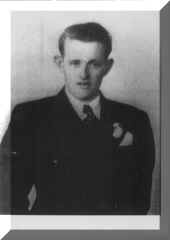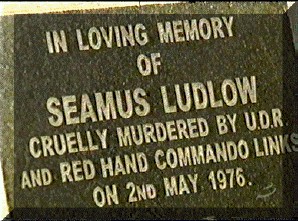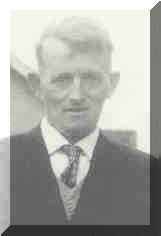


The Murder of Seamus Ludlow in County Louth, May 1976. Towards a public inquiry?
  
The Murder of Seamus Ludlow in County Louth, May 1976. Towards a public inquiry? |
|
More British Army Lies about Seamus Ludlow. Seamus Ludlow's sectarian murder in May 1976 was followed by false, unsubstantiated and disturbing claims that he perhaps wasn't quite the innocent and inoffensive person that his family and his wide circle of friends knew him to be. He was perhaps also in some way responsible for his own death because in some way he must have deserved to die that way. Thus it was claimed that Seamus Ludlow was killed by the IRA because he was an informer. Neither of these claims were true. While the Ludlow family maintained Seamus Ludlow's innocence and defended his personal integrity for many years, they had to tolerate these lies. But now they at last have the very names of the men alleged to be responsible for Seamus Ludlow's murder, and they know also that the RUC had identified the suspects by 1977, and the Gardai had these same names at least as late as 1979, if not much earlier than that. The Ludlow family has proof that these lies were not the mere ramblings of a few Garda officers, they were in fact the result of a coordinated attempt on both sides of the Irish border to disguise the fact that Seamus Ludlow's killers were members of the UDR and the Red Hand Commando. These lies, if they were believed within the wider community, would also reduce public questioning of the Gardai's failure to bring the guilty parties to justice. Few people would have sympathy for an alleged informer so there would be no great outcry if his killing went unsolved. The
British Army was clearly involved in the smearing of Seamus Ludlow
from very soon after the murder was committed in May 1976. Indeed, on
the day after Seamus Ludlow's burial at the Catholic Calvary cemetery
at Ravensdale, County Louth, a party of British soldiers stationed in
south Armagh went to the home of Kathleen Donegan, a sister of Seamus,
who lives in Dromintee, south Armagh, and caused grave offence by
claiming that Seamus must have done something to deserve it, for the
IRA would not have killed him for nothing. Later that day her husband Kevin Donegan was brought by military helicopter from Forkhill to Bessbrook to be questioned about his brother-in-law's murder. It was not immediately clear why the British Army was so interested in the death of a man across the border or why they would want to add to the lies that were already in circulation. Recent revelations might support a suspicion that the British Army had something to hide. The British interest in perpetuating the smearing of Seamus Ludlow did not end with the British Army visit to the Donegan household or the interrogation of the late Kevin Donegan. The Ludlow family later became aware that the death of Seamus Ludlow had begun featuring in books written by British writers allegedly recording the history of the British Army's SAS regiment's activities in Ireland. In essence the victim of pro-British murder gangs in Ireland was enlisted after his cruel death for the British propaganda campaign against Irish republicans. There can be little doubt that the lies must have originated somewhere within the British security establishment.. The discovery of these disturbing references to the innocent victim of sectarian killers within the British Army in the pages of such books confirmed the already strong suspicion held within the Ludlow family circle of a wider conspiracy to discredit the memory of Seamus Ludlow. There was no doubt that such claims were being made by the Gardai in Dundalk and further afield within days of Seamus Ludlow's murder, yet there was not a shred of evidence to support such claims. The IRA both publicly and privately denied any involvement in Seamus Ludlow's murder. As if to confirm that even they did not believe their own lies, the Gardai did not launch any operations against republicans in the border area after Seamus Ludlow's murder. It was to be hoped that the British Army's interest in tarnishing the good name of an innocent victim and causing distress to his grieving family would end with the above mentioned incidents involving the late Kevin Donegan in south Armagh. But sadly, Seamus Ludlow would continue to hold some significance for such elements in the years that followed. This became obvious with the publication of outrageous lies in at least the two books detailed on this page. In Ambush The War Between the SAS and the IRA, published by Pan Books in 1988, the authors James Adams, Robin Morgan and Anthony Bambridge, who clearly had no conception of truth or decency in their rush to write what is little more than a love letter to a British murder gang, have stooped to insult the memory of a decent man. The authors never contacted any members of the Ludlow family before or after rushing to print with disgusting lies about Seamus Ludlow and neither they nor their publisher have responded to recent communications from the Ludlow family demanding an explanation for the slurs which they put into print and a withdrawal of the offending passages. Clearly there is no apology expected soon from Pan Books or its authors, but the Ludlow family is determined to pursue this issue in its own time. Here are the lies which have been spread by Adams, Morgan and Bambridge (page 78):
It is perhaps typical of such books that the alleged "facts" are never supported. No attempt is made to source or substantiate the cruel slur on the character of an innocent victim. It is the Ludlow family's sincere belief that no such evidence exists, and that the slur is a mere invention of the unnamed army or intelligence sources who supplied the authors. In another offensive book also published by Pan, The SAS in Action (Revised 1998), by Peter MacDonald, very similar lies are found on page 72:
This again is a classic example of the facts being changed for propaganda purposes. Seamus Ludlow's murder which should have been an embarrassment to the British Army, with long-suppressed facts of UDR involvement being revealed as this revised edition was going to press, was once again being dusted down for cynical purposes. Seamus Ludlow was to be seen as a man deserving of no sympathy in two countries - a "terrorist" in Britain and an "informer" in Ireland. He was a casualty, not an innocent victim. He was meant to be forgotten by many and remembered by many more as a person of little worth who probably was the author of his own destruction. Once again, letters sent by the family to Mr. MacDonald and his publisher have been ignored. It seems that when they are confronted with their lies these apologists for the SAS murder gangs and their Loyalist cohorts have nothing to say to the Ludlow family. It may be a matter of no importance to the authors of these lies about Seamus Ludlow, that there are reports, dating from 1979, that the Gardai received information from the public which points to the presence of an identified British soldier inside the Lisdoo Arms premises at around the same time that Seamus Ludlow was seen there. There are further reports of a northern registered car, with three men inside, parked nearby. These claims were published by the author Michael Cunningham, following his private investigation in the Dundalk area in 1978. The following is an excerpt from a letter to the publisher, Pan Books, dated 3 November 1998: "These statements published by you are absolutely untrue and they have caused deep hurt to our family for many years in that they perpetuate the smear cast on the memory of an innocent victim who was cruelly taken from us. Your writers never knew Seamus Ludlow, nor did they contact any member of our family, yet they seemed quite confident in writing deeply offensive statements about him, statements which are neither sourced nor factual. "Our family has never accepted the lies and we have fought long and hard to restore Seamus Ludlow's good name. We hope that you will respond favourably to our demand in the light of the mounting evidence which supports our case. "We demand that these false statements are withdrawn and that an apology appears in all future editions of these books. We also demand that similar action should be taken with any other books carrying this lie which we are unaware of, and published by your company. It is in your own interest to do this because these publications are now discredited. "We require some explanation from you as to why such unsubstantiated statements were published by your company. We also demand that you reveal the source from which the authors obtained these allegations. . .". As noted above, no replies were ever received!
I Top I Download the Barron Report from the Oireachtas website (pdf file) SUPPORT THE SEAMUS LUDLOW APPEAL FUND Bank of Ireland 78 Clanbrassil Street Dundalk County Louth IrelandAccount No. 70037984 Thank You.
|